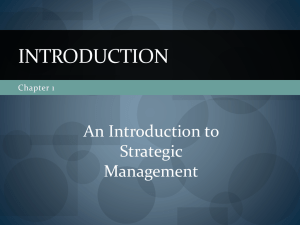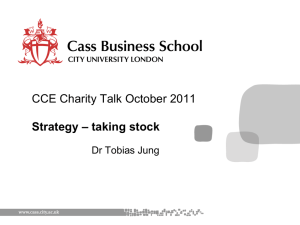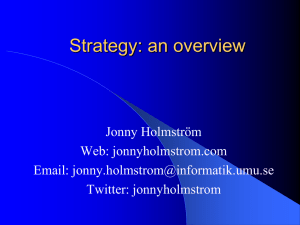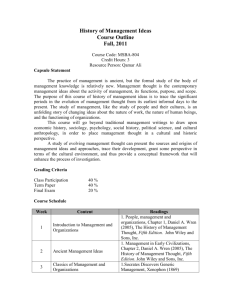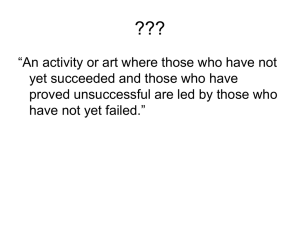File
advertisement
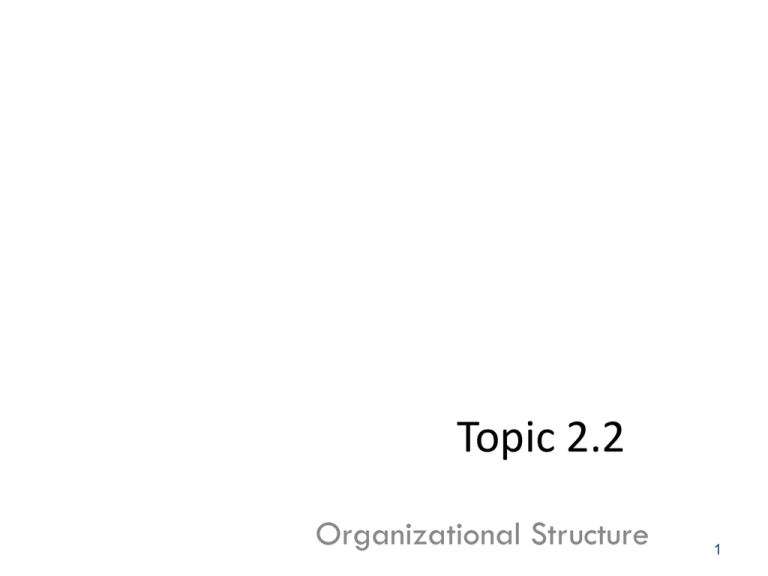
Topic 2.2 Organizational Structure 1 Organization Structure • Formal Organization: – “Refers to the official structures of command and control that exists in an organization.” – The formal relationships of authority. – Authority is delegated from senior middle junior managers. • Managers delegating are responsible of the outcomes. – Each level of management will tend to have written/unwritten rules that outline what can & cannot be done. 2 Continued… – The “formal organization” takes into account: • • • • • The relationships between individuals; Who is in charge; Who has authority to make decisions; Who carries out decisions; How information is communicated. 3 Continued… • Delegation: – Factors deciding the amount of authority to delegate: 1. 2. 3. 4. 5. The culture of the organization; The ability of the subordinate; The consequences of getting the decision wrong; The expectations of the managers and the subordinate; The amount of work the manager and subordinate have to do. 4 Continued… • When is delegation likely to be effective? – Employees need to be empowered in order to make effective decisions. – If managers only delegate when they are overloaded, subordinates may be resentful. – Managers should: • Plan and take time to explain delegated tasks clearly. • Allow participation. • Avoid interfering with delegated tasks. • Provide support and resources. – The employee given a delegated task should also be given the authority & responsibility to carry it out. – Delegated tasks should be given to suitable employees. 5 Continued… • Informal Organization: – “Refers to the unofficial organization of personal & social relations that develop in an organization.” – Power comes from informal groups in the organization. – Doesn’t officially exists, thus difficult to set rules and identify individual representatives. – The types of relationship (1993 – study of informal networks in the banking industry – by: Krachhardt & Hanson): A. Advice Networks: who depends on who to solve problems and provide information. B. Trust Networks: which employees share potential information and back each other up in times of crisis. C. Communication Networks: which employees regularly talk to each other on work related patterns. 6 Levels of Hierarchy • Hierarchy: “the order of levels of management in an organization, from the lowest to the highest rank.” • Responsibility: “Being accountable or being required to justify an action.” • Authority: “Ability to carry out the task.” • Levels of hierarchy: – Flat & Tall Organizations – Chain of Command – Organizational Charts 7 Flat & Tall Organizations TALL Organization 8 Continued… • TALL Organizations: – As an organization grows, it is likely that: • People become relatively more specialized; • Rules will need to be put in place; • Lines of command and control will become clearer. – Characteristics: • Bureaucracy: “a system where there are standardized procedures, formal divisions of power, rigid hierarchy, and formal working relationships.” • Long chain of command. • Usually used for stable business environments. • Centralized decision making. 9 Continued… • Advantages: – There is a narrow span of control i.e. each manager has a small number of employees under their control. This means that employees can be closely supervised. – There is a clear management structure. – The function of each layer will be clear and distinct. There will be clear lines of responsibility and control. – Clear progression and promotion ladder. • Disadvantage: – The freedom and responsibility of employees (subordinates) is restricted. – Decision making could be slowed down as approval may be needed by each of the layers of authority. – Communication has to take place through many layers of management. 10 Continued… FLAT Organization 11 Continued… • FLAT Organizations: – Characteristics: • Fewer levels of management. • Decentralized decision making, and employee participation is encouraged. • Managers are closer to subordinates have a more personal working relationship. • Structure aims to create autonomous/independent units that are: – Closer to customers, AND – Can quickly identify and respond to changes in internal and external business situations. 12 Continued… • Advantages: – – – – – Closer relationships Synergy Change accepted faster Spread of decision making Motivation • Disadvantage: – Decision making slow and frustrating as so many employees involved – Confusing as the source of power and decisions are less clear compared to tall 13 Chain of Command • “The line of authority and responsibility along which orders are passed in a formal organization.” • Should consider two factors: – The number of links/levels in the chain of command. • Each extra level of management in the hierarchy 25% less effective communication. – Span of control: “number of subordinates working under a manager.” • Henri Fayol argued that the span of control should be between three & six because: – There should be tight managerial control from the top of the business; – There are physical & mental limitations to any single manager’s ability to control people and activities. 14 Organization Chart • “a diagram that shows the official working relationships in an organization.” • Identifies: – Levels of hierarchy (tall/flat) – Chain of Command (short/long) – Span of Control (narrow/wide) – Scope of Delegation 15 Continued… • Why do organizations produce/use such charts? – To spot communication problems; – Helps individuals to see their position in the business (who their accountable to and have authority over as well as motivate to reach their anticipated targets, in terms of job ambition); – Allow firms to pinpoint areas where specialists are needed; – Show how different sections of the firm relate to each other. 16 Continued… CEO Sales Director Finance Director Sales Manager Financial Accountants Salespeople Financial Assistants Accounting Clerks Production Director Production Supervisors HR Director Personal Officer Personal Assistants 17 Centralization • “Concentrating decision making in a particular location or group.” • Complete Centralization subordinates have no authority at all. • Disadvantages of centralization: – Sometimes some decisions are to be taken immediately at the spot, but due to centralization, none of the decisions can be made without permission of top level managers and it results in financial loss of organization. 18 Continued… – Participation from lower levels can be used as motivating tools, in centralization there is a little participation from lower levels, those who are at lower levels, when feel that they are not directly responsible for the operation they might not take their work seriously and show a poor performance. – In centralized environment middle level managers just serve as a link to carry out decisions of top level managers from lower level managers. Middle level managers might not work efficiently due to less authority. – In centralized environment the credit of work of junior employees sometimes is taken by Officers and gain promotion and rewards, that demoralizes the employees and next time they will not give their best to their work. 19 Continued… • Advantages of centralization: – Senior management have more control of the business – Procedures, such as ordering and purchasing, can be standardized throughout the organization, leading to economies of scale and lower costs – Senior managers can make decisions from the point of view of business as a whole – Senior managers should be more experienced and skilful in making decision – Business may need strong leadership by a central group of senior managers – Communication may improve if there are fewer decision makers 20 Decentralization • “Decision making is largely dispersed/ isolated to outlaying bit/fragments of the organization.” • Disadvantages of decentralization: – Staff must be trained to handle decision making, and this may require expensive formal training program. – Since many managers have worked in centralized organizations, it is uncomfortable for them to delegate authority in a decentralized management. Their attitudes are difficult to alter, and attempts often lead to resistance. 21 Continued… – Another problem that comes with the decentralization is complexity of organization structure. In centralization organization structure is simple, whereas in decentralization this structure is rather complex. 22 Continued… • Advantages of decentralization: – Empowers and motivates workers – Reduces stress and burdens of senior management – Provides subordinates with greater job satisfaction by giving them more say in decision making – Subordinates may have a better knowledge of “local” conditions affecting their area of work – Delegation should allow greater flexibility and a quicker response to changes – Management at middle and junior levels are groomed to take over higher positions 23 Organisational Charts - Construction • • • • • • • • • • • CEO 4 Directors 5 sales staff 4 production staff 6 hr staff 4 accountants 4 sales trainees 2 Production managers 1 Sales Manager 1 HR manager 1 Finance manager 24 Organisational Charts - Construction • • • • • • • • • • • • 4 Sales staff 2 Finance managers 3 Directors 3 Shareholders 2 Production assistants 5 Production workers 2 HR managers 2 Accountants 2 Trainee accountants 5 Sales assistants 1 Sales manager 1 Production Manager 25 Organisational Charts - Construction • • • • • • • • • • 5 Directors 5 Sales assistants 5 Finance managers 4 Accountants 2 CEO’s 3 Production assistants 3 Production Managers 2 Sales managers 5 Production workers 5 Student sales workers 26 Analyse consequences of delayering • +ve – there will now be more ideas communicated between workers/subordinates and senior management which will aid in creating SYNERGY • +ve – Employees will feel more motivated because their ideas/opinions are being heard by senior management and they will now receive more EMPOWERMENT as staff now will be given more AUTHORITY to carry out decision making in the absence of their once line managers, now unemployed 27 Analyse consequences of delayering • -VE – Staff are now promoted through default to a more empowered position and so they may not have the experience/skills to make correct decisions for the company so it could lead to poor decision making/inefficiency • - VE – Unclear lines of decision making power could lead to slow decision making when superiors have to filter through so many ideas/decisions coming from subordinates now 28 HL Exam Expectations • Discuss the development of more flexible organizational structures. • Apply the theories of writers such as Mintzberg and Peters. • Evaluate the role and importance of the informal organization. • Analyse the reasons behind, and the effects of, moving some human resource functions to external organizations located nationally or globally. • Evaluate whether firms will benefit from outsourcing, offshoring and the migration of human resource functions. 29 Forms of Business Structure The Entrepreneurial Structure II. The Bureaucratic / Pyramid / Hierarchical Structure III. The Matrix Structure IV. The Independence Structure I. 30 Continued… I. The Entrepreneurial Structure – All decisions are made centrally. – Few collective decisions and great reliance on “key” workers. – Often found in businesses where decisions have to be made quickly (ex: newspaper editing). – Small businesses use this structure as well, as the businesses rely on the expertise of one or two people to make decisions. – Effective decision making: quick decisions + accountability is known + little consultation is required. Decision Maker 31 Continued… The Bureaucratic / Pyramid / Hierarchical Structure Decisions Traditional hierarchical structure for most medium and large organizations. Decision making is shared. Specialization of tasks allow the business to enjoy economies of scale. Criticism: structure cannot meet new & changing demands. Directors Information II. Department Managers Middle Managers Employees 32 Continued… III. • The Matrix Structure The basis for the matrix organization is an endeavor to create synergism through shared responsibility between project and functional management. Other advantages of a pure matrix organizational form, to project management, include: – Because key people can be shared, the project cost is minimized – Conflicts are minimal, and those requiring hierarchical referrals are more easily resolved – There is a better balance between time, cost and performance – Authority and responsibility are shared – Stress is distributed among the team – Matrix management: “involves coordinating and support of specialist teams within a matrix structure”. 33 Continued… www.visitask.com/matrix-organization.asp 34 Henry Mintzberg • He suggested that a firm can only remain successful if the structure is flexible enough to deal with rapid changes. Henry Mintzberg Henry Mintzberg 1. Ideology refers to the culture (beliefs, values and traditions) of the organisation. 2. Strategic apex refers to the senior management team, i.e. the key decision-makers. 3. Middle line refers to the team of middle management in the organisation. 4. Operating core refers to the operational processes within the organisation. 5. Techno structure refers to the technical support team and systems. 6. Support staff refers to the team of staff support outside of operational processes and technical support, such as clerical staff and those working in public relations. Henry Mintzberg • Six organisational configurations (all may exist but one likely to dominate). 1.Innovative organisation or adhocracy – Small project teams (silos) dealing with specific problems. – Decentralised – No standard procedures – Very flexible Henry Mintzberg 2. Entrepreneurial organisations – Decision-making retained by the strategic apex (flexible and responsive) – Direct supervision and centralised Henry Mintzberg 3.Machine Organisations – Coordination by operating core or technostructure – Specialization and standardisation (machine bureaucracy). – Formal procedures – Clear communication – inflexible Henry Mintzberg 4.Divisionalised Organisations – Organized by middle management – Standardised – Inflexible (although delegation and decentralisation can overcome this). Henry Mintzberg 5.Professional Organisations – Those with standardised skills make up operating core. – Inflexible as they tend to be highly specialised Henry Mintzberg 6. Missionary Organisation • Coordination through standardised norms (ideology) • Every individual operates with the same beliefs Henry Mintzberg • Different configurations suit different businesses, i.e. capital intensive firms suit machine bureaucracy. • Adhocracy and entrepreneurial organisations are the most flexible and therefore more likely to embrace change. • For the structure to work properly employees must believe in the organisation’s ideology. Tom Peters • What did you find out about Tom Peters? Tom Peters • Flatter = better communication, more delegation, more empowerment, and greater flexibility. • Promotes innovation and commitment from the workforce. • 2 features contribute to the flexibility of structures 1. Removal of bureaucracy • Eliminates constraints through removal of rules and regulations. 2. Use of project teams • (Matrix) should allow innovation Henry Mintzberg HL • Six organizational frameworks, or coordinating mechanisms in an organization: (Page105) – Direct Supervision – Output Standardization – Skills Standardization – Process Standardization – Adjustment – Norms Standardization 47 HL Continued… • Six parts of an organization: (Page106) M O Middle Mgmt Operating Core S Strategic Mgmt T Technostructur e I Ideology S Support Staff 48 HL Tom Peters • Wrote a book with Robert Waterman (1982) suggesting eight features of organizations that achieved excellence: 1) 2) 3) 4) 5) 6) 7) 8) Get things done. Understand your customers’ needs. Be independent and innovative. Achieve productivity through people. Be hands-on get involved in the organization. Only do what you do best. Have a simple organization structure and lean staff. Directly control core activities but delegate or outsource peripheral (secondary/minor) ones. 49 Continued… HL • Peters provided seven pointers for analyzing the set up of an organization “The Seven ‘S’ Framework”: (Page107) – The “Hard S’s”: Strategy Structure Systems – The “Soft S’s”: Staff Style Shared Skills 50 Outsourcing, Offshoring, & Migration of HR HL Functions • Outsourcing – “When an organization gets a sub-contractor to undertake part of its production process.” – Example: Coca-Cola appoints a marketing agency to market its range / Toyota Motor Company (assembler). – Enables an organization to cut costs + focus on what it believes it does best. • Offshoring – “the relocation of an organization’s activities from one country to another.” – Many organizations relocated their activities to India & China..WHY? • Migration (Slides : 3 & 5) 51 Continued… HL • HR function usually includes: (Page 108) – – – – – – – Payroll Work Time Benefits Administration The HR Management Information System (HR MIS) Recruiting Dismissal and Redundancy Public Relations (PR) • Analyze reasons behind, and effects of, moving HR functions to external organizations located nationally or globally. 52 Analyze reasons behind, and effects of, moving HR functions to external organizations located nationally or globally. • Recruitment time and costs increase • On the Job/Off the Job training needs of new staff may increase = increased costs • Dismissal/redundancy/delayering of some staff will be costly initially & cause demotivation to remaining staff • Labour costs likely will decrease if use company in another or relocate to another country – lowers overall costs • May improve public relations of the company by creating jobs in other countries • May give opportunity to hire more experienced/specialised staff to improve HR operations 53
